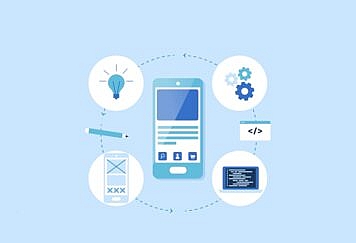.NET offers a rich choice of libraries and toolkits for building powerful software of different types, including desktop applications. Let’s explore the advantages of leveraging .NET in desktop development, compare .NET and Java, learn the essence of popular .NET frameworks, and overview desktop app deployment methods.
Why Choose .NET for Desktop Development
Rich language support
C#, F#, and Visual Basic programming languages are all supported in .NET software development. What is more, they are interoperable, which allows developers to easily collaborate while using the languages they prefer.
Cross-platform development
.NET Core enables the development of cross-platform desktop applications to be installed on Windows, Linux, and macOS. This helps to reach a larger user audience with less investment.
Robust security management
.NET development tools feature secure authentication and authorization, role-based access control, as well as Microsoft’s solution for restricting code actions – code access security. Such a solid approach helps to keep untrusted parties from accessing and modifying .NET apps.
Variety of deployment methods
Desktop apps developed with .NET have multiple installation methods, including installer packages, Microsoft Store installation, and ClickOnce. The variety makes it simpler for app developers to adjust a distribution model to their individual business needs.
Large and active community
Backed by Microsoft, the online .NET community is large and supportive. Engineers who encounter troubles during development can easily find tutorials or get answers to their questions on forums, messaging boards, and in dedicated Discord servers.
.NET vs. Java
Similar to .NET, Java is also widely popular in desktop application development. Let’s compare the two technologies and see how they differ.
- Programming language options. While .NET developers can write application code in C#, C++, and Visual Basic, Java engineers can only rely on Java.
- IDE options. As a rule, NET developers work in Microsoft-owned integrated development environment Visual Studio. At the same time, Java engineers have a wider choice of IDEs, including Eclipse and IntelliJ IDEA.
- Cross-platform apps. Before the release of .NET Core, Java was the only technology supporting cross-platform desktop app development for Windows, macOS, and Linux. Initial .NET did not offer this, which frequently made Java a smarter alternative. However, there isn’t much of a difference in this respect today.
- Performance. .NET and Java alike help create high-performing desktop applications of any scale. Still, the performance of .NET apps can be slowed down by .NET runtime overhead and Java apps – by the Java Virtual Machine (JVM).
- Frameworks. Java’s frameworks are believed to be more flexible due to their modularity, whereas .NET’s are more tightly integrated and allow for more consistent engineering.
Since both technologies have their advantages, the decision to opt for .NET or Java development services often depends on project and business needs as well as on the composition and competencies of an existing team.
How to Choose a .NET Framework
If your desktop app project team settled for .NET technology, their next key move is the choice of a .NET framework. .NET provides developers with several options for creating desktop applications, including UWP, WPF, and Windows Forms. Each of these technologies offers unique advantages and caters to specific use cases, allowing developers to choose the best option.
Below, we briefly review each of the popular options.
Windows Forms
Windows Forms or WinForms is one of the oldest .NET frameworks. Aside from featuring many built-in kits, Windows Forms has a very intuitive UI with drag-and-drop functionality. The UI makes this framework extremely easy to get used to and guarantees a consistent look and feel across different Windows versions.
WinForms requires knowledge of C# and is mostly used for small and simple applications or software prototypes. Sadly, when it comes to complex apps with heavy GUI, it can’t offer much.
Windows Presentation Foundation (WPF)
Released in 2006, WPF is a proven framework for building desktop apps that run on Windows 7-11. Compared to WinForms, it has all the necessary tools for developing sophisticated and eye-catching desktop apps with responsive and dynamic UIs. It’s not surprising that WPF is the most common choice of a .NET framework.
WPF supports C#, C++, and Visual Basic. It’s also open-source and has over 60,000 developers continuously contributing to its improvement.
Universal Windows Platform (UWP)
UWP is the latest cross-platform tool for building modern Windows 10+ apps that run on PCs, laptops, tablets, smartphones, and Microsoft AR/VR hardware. This framework allows developers to create apps that feature Cortana-based voice control as well as touch, ink, and gamepad input.
Universal Windows Platform supports C#, C++, and Visual Basic. It is also integrated with the Visual Studio toolbox, which helps developers to significantly speed up UI implementation and enhance app security.
Deployment
.NET offers several app deployment options, such as traditional desktop installation, web deployment with ClickOnce, and Microsoft Store publication. This flexibility enables developers to deploy applications across different environments and devices, making it easier to reach a wider audience.
Installer Package
Deploying a .NET desktop application via an installer package is the most typical method. App developers simply create a separate installer package with all the needed files and dependencies – and the user launches the installation on their device. Tools like InstallShield and Visual Studio Installer make it easy for engineers to create the packages and for users – to follow installation steps.
ClickOnce
As the name suggests, the ClickOnce deployment method only expects users to make a single click to have the app installed locally. To enable this convenient and minimalistic type of deployment, developers need to upload software to a web server or shared network (for instance, FTP) and share the link on the website or a social network.
Publication to Microsoft Store
Publishing an app to Microsoft Store is only possible if you develop your app with UWP. After completing development, developers can leverage Desktop Bridge to create an MSIX package, which they later upload to Microsoft Store. After the app passes moderation, it becomes available for users to download and install.
Wrapping Up
.NET is a powerful and versatile framework that offers many benefits for developers, including seamless integration with Microsoft technologies, a vast array of development tools and libraries, and robust security features. With its broad range of tools and deployment options, it remains a top choice for businesses and organizations of all sizes.
Follow TechStrange for more!





